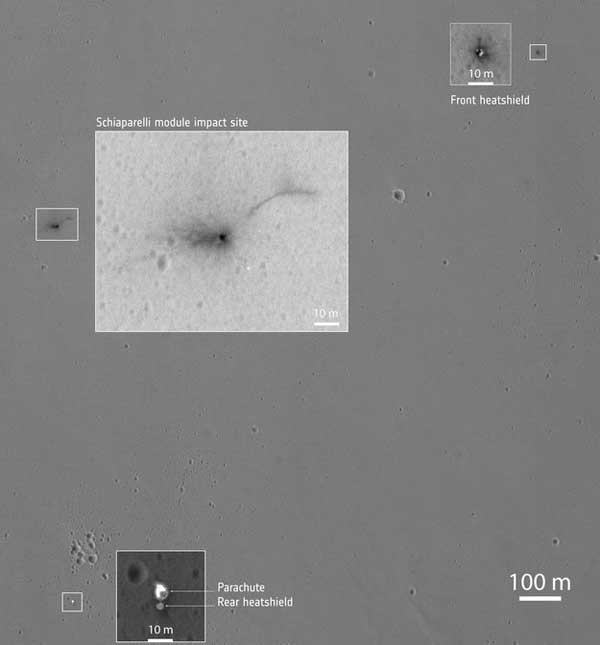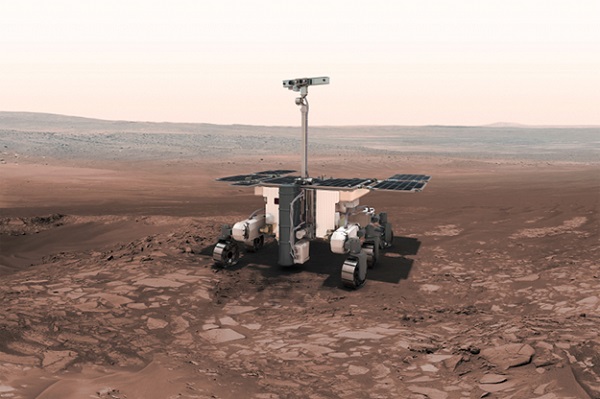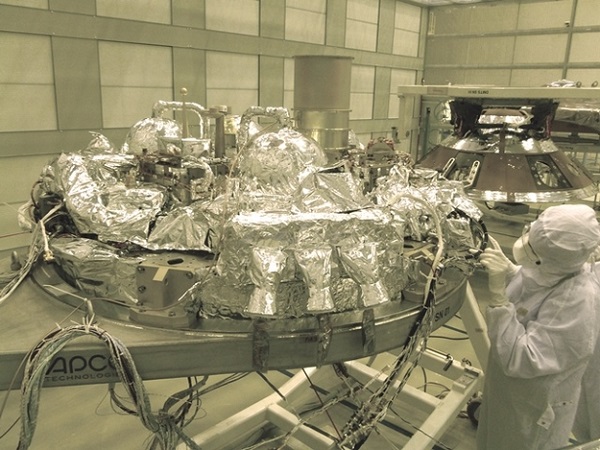Astronomy - Schiaparelli: Requiem for a Mars Lander
New glimpses from the Mars Reconnaissance Orbiter and ongoing data analysis are revealing the fate of the Schiaparelli lander.

The Mars Reconnaissance Orbiter's newest image of Schiaparelli's landing site.
NASA / JPL-Caltech / University of Arizona
NASA / JPL-Caltech / University of Arizona
A week after Schiaparelli's fatal plunge, a picture is emerging (literally) to explain what happened to the ExoMars lander.
There is no shortage of derelict spacecraft dotting the surface of Mars, some of whose ends have remained mysterious for decades. But unlike the loss of Beagle 2 in 2003 or NASA's Mars Polar Lander in 1999, the European Space Agency's Schiaparelli Entry, Descent and landing Module (EDM) demonstrator was designed to transmit data though all stages of descent. The Giant Metre-wave Radio Telescope tracking station in Pune, India and ESA's very own Mars Express were listening to the lander’s “six minutes of terror,” during entry and descent.
What Happened to Schiaparelli?
Based on that data, here's what appears to have happened. Atmospheric braking against the tenuous Martian atmosphere and parachute deployment were flawless and on time. Then, about 90 seconds prior to landing, things went awry.
First, the module jettisoned its heat shield and parachute early. Then to make matters worse, a computer glitch seems to have confused the lander, as miscommunication between its onboard navigational system and radar erroneously told Schiaparelli it was near the surface. So the braking rockets shut off after burning for only 3 seconds rather than the planned 60 seconds. At about 2 to 4 kilometers (1 to 2.5 miles) above the surface, Schiaparelli went into free fall.
Ultimately, Schiaparelli slammed into the Meridiani Planum region of Mars at an estimated 300 kilometers per hour (186 mph). The lander most likely exploded on impact. This past Friday (October 21st), NASA's Mars Reconnaissance Orbiter captured a view of an ugly new crater of Mars, as well as a white spot that appears to be the parachute, which seems to bear this story out.
Engineers are still going over the descent data, and there's a small chance we might still see some of those images that the Descent Entry Camera (DECA) imager snapped every 1.5 seconds on its all-too-swift fall.
In its briefing last Thursday (October 20th), European Space Agency (ESA) officials were careful to stress that Schiaparelli was only intended as a landing demonstration test. Lessons learned will be applied to the full up ExoMars rover scheduled for the 2020 launch window. The spacecraft manufacturer, Alenia Aerospace, will deliver an interim report on Schiaparelli next week, with a final mission report the following week.
“We have collected all of the engineering data that the EDM has produced during this [descent] phase,” said ESA Spacecraft Operations manager Andrea Accomazzo during the ESA press conference. “This is the most important part of any test: to collect data.”
An Unclear Path

In this artist's conception, the ExoMars rover explores the Red Planet.
ESA
ESA
While Schiaparelli provides useful lessons, the Roscosmos and ESA agencies will want the 2020 rover to reach the Martian surface intact. Funding may become an issue: there’s currently a 300 million Euro shortfall for the ExoMars rover’s budget, which the ESA is expected to request from European Union member states this December. Not to mention, the rover has already slid back one 26-month Mars launch window, from 2018 to 2020.
“At this point, no one wants to think about flipping to 2022,” ExoMars project scientist Jorge Vago noted in aNature News interview earlier this week. “It would have been much nicer to be able to go to the ministers with a mission where both elements (the Trace Gas Orbiter and the Schiaparelli lander) had performed flawlessly.”
For now, just what the performance of the Schiaparelli lander means for the future of ExoMars program is unclear, though engineers will be reliving the final moments of the lander's descent through computer simulations to work up a fix.

Schiaparelli in the lab, undergoing decontamination testing.
ESA
ESA
Now for the good news: a software glitch should be a relatively easy fix, as opposed to the prospect of re-engineering a fundamental flaw in the hardware. And yes, in keeping with planetary protection protocols, the Schiaparelli EDM lander underwent a full decontamination on Earth.
Meanwhile, the ExoMars Trace Gas Orbiter is safely in orbit around Mars and open for business. The orbiter will now begin a year-long period of aerobraking, flying through Mars’s rarefied atmosphere during its closest approach to Mars, 298 kilometers above the planet’s surface, to bring its orbit a little closer to Mars.
No comments:
Post a Comment